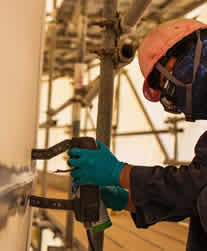
About Non Destructive Testing (NDT)
Non Destructive Testing (NDT) refers to the testing of material and components without inhibiting its further usefulness. Applied scientific principles such as electromagnetic induction, magnetism, capillary action, mechanical vibration, electromagnetic waves, etc. are utilised to identify and characterise discontinuities within tested samples or areas of interest.
Training for NDT is provided by the SAIW in compliance with the ISO/TS 25108 in accordance with the syllabus provided in ISO/TS 25107 (ASNI/ASNT CP 105 as well as IAEA Tecdoc 628 are also incorporated) and recognised by an ISO/IEC 17024 accredited Personnel Certification Body (PCB) under the scope of ISO 9712, i.e. SAIW Certification PCB, which operates the SAIW Certification NDT Scheme.
The SAIW Certification NDT scheme is the very first NDT qualification and certification scheme developed ‘in Africa by Africans for Africans’ that is registered under the ICNDT Mutual Recognition Agreement (MRA) Schedule 2 through the SAIW Certification Personnel Certification Body (PCB).
TRAINING IS SECTOR SPECIFIC AND CAN BE SUBDIVIDED INTO THE FOLLOWING MAIN SECTIONS:
| 1. | Terminology and history |
| 2. | Physical principles |
| 3. | Product technology and method capabilities |
| 4. | Equipment |
| 5. | Testing information |
| 6. | Interpretation / evaluation and reporting |
| 7. | Assessment |
| 8. | Quality Aspects |
| 9. | Developments |
Assessment quality aspects and developments training, qualification and certification is subdivided into three levels as stipulated by ISO 9712 new issue published in 2021.
|
|
An individual certified to LEVEL 1 has demonstrated competence to carry out NDT according to written instructions and under the supervision of Level 2 or Level 3 personnel. Level 1 personnel may be authorized to perform the following in accordance with NDT instructions: set up NDT equipment; perform the tests; record and classify the results of the tests according to written criteria; report the results. |
|
|
LEVEL 2 personnel may be authorized by the employer to perform certain tasks which include: select the NDT technique for the testing method to be used; define the limitations of application of the testing method; translate NDT codes, standards, specifications, and procedures into NDT instructions adapted to the actual working conditions; set up and verify equipment settings; perform and supervise tests; provide guidance for personnel at or below Level 2; report the results of NDT. |
|
|
LEVEL 3 personnel may be authorized to perform certain tasks which include: assume full responsibility for a test facility or examination centre and staff; interpret standards, codes, specifications, and procedures; carry out and supervise all tasks at all levels; provide guidance for NDT personnel at all levels. |
Email : ndt@saiw.co.za


